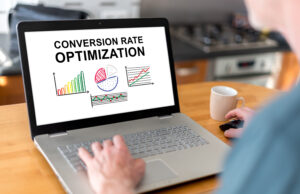
The modern shopping cart makes it possible to quickly and easily add products, check out, and pay.
As a result, businesses and their marketing departments place more emphasis on increasing website visitors in the hopes that some of them will become quality leads and, ultimately, customers.
A huge and steady flow of visitors to a company’s website must be wonderful, but what good does that alone do the business? Having a lot of visitors is different from getting a high return on investment (ROI). Although many people may visit your site, only a fraction of them may become paying customers. What you need is conversion rate optimisation (CRO).
Understanding CRO
CRO is used in online marketing to boost the fraction of site visitors who respond favorably to a call to action (CTA). There are several different conversions; some of the most common are:
- Sales
- Newsletter sign-ups
- Registration
- Product subscription
- Content downloads
Conversions matter greatly because they’re essentially goal completions. It’s always a thrill when a customer who’s just passing through your shop decides to purchase one of your offerings.
Tips For Successful CRO
You can increase ROAS through CRO, improve your landing page, and consequently increase revenue and sales. ROAS stands for ‘return on advertising spend’ and is a metric used to evaluate the efficiency of an advertising campaign. Here are some easy actions to take to build your CRO plan and create a more profitable business.
- Build A Landing Page That Converts
Regardless of your business’ niche, the landing page is a crucial component of your website. Why? Because that’s where people from your target demographic will go, whether they click on your banner ad or find your site in the organic search results. In addition, a visitor’s first impression of your company will be based on your landing page.
Therefore, you should focus on making a landing page that’s both attractive and effective. The best landing pages are streamlined, well-organised, and simple to use.
- Invest In A Faster Page Speed
Website performance, or website speed, is the rate at which a browser can completely load a fully functional website. The loading time of your website affects not only your conversion rate but also the success of your online store as a whole.
- Bounce Rate. The ‘bounce rate’ measures how often people visit a website and immediately leave after viewing only that page. Website visitors are more likely to abandon your site if it takes long to load.
- SEO. Google’s goal is to provide users with timely access to quality information. Because of this, Google considers a site’s speed when determining its search engine ranking. With Google’s switch to mobile-first indexing, making sure your site loads quickly on mobile devices is crucial.
- User Experience. Today’s impatient consumers aren’t going to wait for you when they can find the same or similar products elsewhere in a matter of seconds using a search engine.
Consider investing in page speed optimisation services if your in-house developers need help. These services will assist your business in increasing its page speed, increasing your conversion rates, and bringing in more customers and income.
- Optimise Your CTA
You may be making a big mistake if you spend 15 hours designing your landing page but only three minutes on your CTA button. Your landing page’s conversion rate is affected by every element, including this little clickable zone.
CTAs can be in various formats, such as buttons, pop-ups, hyperlinked text, and sliders. Learn how to optimise conversions by implementing these in your CTAs:
- Keep your CTAs brief
- Create urgency
- Personalise your CTAs
- Make the CTA stand out
- Keep testing
If you don’t have an appealing offer or a compelling reason for someone to click and take action, they won’t do it. Similarly, your audience can just scroll right past your CTA if it doesn’t stand out well enough, has no emotion, or doesn’t have an appealing visual design. Because of this, you should put just as much importance on the overall appearance and feel of your CTAs as you do on the other elements of your website. This will help ensure that your calls to action are effective.
- Delete Unnecessary Elements Or Content From Your Website
This step is one of the best CRO strategies since it allows you to prevent on-page distractions like pop-ups while having no effect on off-page interruptions like a phone call. Distractions on the page are usually the consequence of many parties seeking to get their message through. But putting a lot of distractions can discourage visitors from staying on your website. Therefore, it’s best to reduce them.
Conclusion
CRO is a crucial aspect of digital marketing, as it helps maximise conversions and improve the ROI. By continually evaluating and refining the design and functionality of your website or landing page, you can increase the likelihood of conversions and achieve your marketing goals.
Read more:
How To Get Started With Conversion Rate Optimisation?

